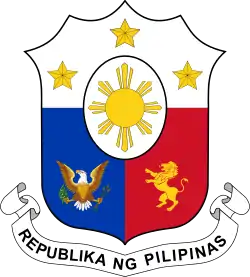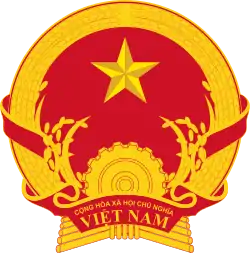Philippines–Vietnam relations
The Philippines–Vietnam relations refers to the bilateral relations of the Republic of the Philippines and the Socialist Republic of Vietnam. Since the end of the Cold War, relations between the two countries have warmed significantly. Vietnam is sometimes referred to as the only communist military ally of the Philippines. Both nations have cooperated in the fields of education, tourism, agriculture, aquaculture, trade, and defense. Additionally, both nations have similar positions on the South China Sea issue, with Vietnam backing the Philippine victory in the ICC against China, and the Philippines backing to a certain extent the claim of Vietnam in the Paracels. Both nations have overlapping claims in the Spratlys, but have never made military confrontations as both view each other as diplomatic allies and ASEAN brethren.
 | |
Philippines |
Vietnam |
|---|---|
Early history
Relations between the Philippines and Vietnam began centuries ago. There was proof that inhabitants of both countries were already involved in maritime trade prior to the arrival of Europeans. Ships from Luzon in the Philippine archipelago came to the great port of Vietnam in the Gulf of Tonkin to trade. Maritime trade relations were disrupted with the conquest of the Philippines by the Spaniards in the 16th century and the conquest of Vietnam by the French in the 19th century.[1]
Chams who migrated to Sulu were Orang Dampuan.[2] Champa and Sulu engaged in commerce with each other which resulted in merchant Chams settling in Sulu where they were known as Orang Dampuan from the 10th-13th centuries. The Orang Dampuan were slaughtered by envious native Sulu Buranuns due to the wealth of the Orang Dampuan.[3] The Buranun were then subjected to retaliatory slaughter by the Orang Dampuan. Harmonious commerce between Sulu and the Orang Dampuan was later restored.[4] The Yakans were descendants of the Taguima-based Orang Dampuan who came to Sulu from Champa.[5] Sulu received civilization in its Indic form from the Orang Dampuan.[6]
Philippine-Vietnam relations during the Cold War
 | |
Philippines |
South Vietnam |
|---|---|
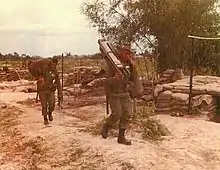
The Philippines was initially aligned with South Vietnam and provided them humanitarian aid in the Vietnam War.
Before the Fall of Saigon, which preludes the disestablishment of South Vietnam, the Philippines was already preparing to establish relations with North Vietnam. President Marcos authorised his wife, First Lady Imelda Marcos, to make direct contacts while she was conducting state visits to Middle-eastern countries in early 1975. The communist takeover of Cambodia and the impending defeat of South Vietnamese forces led Manila to establish ties with Hanoi. The move was not seen as surprising as it was in line with Marcos' foreign policy to strengthen ties with socialist states in order to broaden economic and trade ties.[1]
On July 9, 1976, Vietnam Deputy Foreign Minister Phan Hien arrived in Manila to discuss the formal establishment of ties between the two countries. On July 12, 1976, formal relations were finally established with the Philippines[7] the fourth country in the ASEAN to establish relations with the Socialist Republic of Vietnam after Malaysia, Indonesia and Singapore. The Philippines and Vietnam opened their respective embassies in 1978.[1][8]
Among the first problems to test the relation between the two countries was the repatriation of 14 Filipinos and 10 Vietnamese families who were still in the city of Hồ Chí Minh, attempts of Vietnamese nationals to illegally enter the Philippines by claiming themselves to be members of Filipino families, and the involvement of Filipinos in the black market was received by the Philippine embassy. These issues hampered relations until the early 1980s.[1]
Post-Cold War relations


Despite Vietnam's alignment with the Soviet Union and the Philippines with the United States during the Cold War, bilateral ties between the two countries can be recently described as friendly. On October 26, 2011, Vietnamese President Truong Tan Sang made a state visit to the Philippines where he met with his Filipino counterpart, President Benigno Aquino III. The two countries signed four agreements on naval, coast guard and tourism as part of the Philippine-Vietnam Action Plan 2011–2016 framework.[9][10][11] A Memorandum of Understanding agreement supported information sharing between the Philippine Navy and the Vietnam People's Navy.[12][13]
Despite being victims of Typhoon Haiyan themselves, although the damage Haiyan made to Vietnam was not so big like expected,[14] the Vietnamese still donated to help the Philippines in its rehabilitation efforts after the natural disaster, through Vietnam Red Cross Society.[15]
South China Sea disputes
The Philippines and Vietnam have territorial disputes over the Spratly Islands, among with Brunei, China, Malaysia, and Taiwan. The Philippines and Vietnam both disapprove of China's nine-dash map which China uses as justification of its claim in the South China Sea.[16][17][18] Both countries were also committed to a multilateral diplomatic approach to the resolution of disputes in the South China Sea with the UNCLOS taken to account.[12]
In December 2015, pirates believed to be from the Moro Pirates, rogue Muslim Filipinos wanted for war crimes in the Philippines, murdered a Vietnamese fisherman in the South China which sparked a strong protest from the Vietnamese side. The event also sparked outrage from the Philippine side, who was persecuting the wanted criminals who may have been influenced by Islamic terrorism. Both Vietnam and the Philippines have upheld a variety of international agreements against terrorism in the region.[19]
In 2016, after a legal battle in The Hague, the International Court of Justice of the United Nations ruled in favor of all arguments of the Philippines against China's claims in the South China Sea, effectively destroying China's claims in the international legal arena. However, China waved the international court's ruling despite being a signatory on the respect to international laws and UNCLOS and sent more military vessels in the South China Sea, replacing corals reefs with man-made islands that house military bases and missile launchers. Vietnam formally supported the Philippines in its arbitration case against China regarding China's nine-dash claim over the South China Sea from start to the very end.
In August 2017, Vietnam pushed for the inclusion of a stronger statement against Chinese movements in the South China Sea.
In May 2019, after a Chinese vessel rammed and sank a civilian Filipino vessel and left 22 Filipino fishermen adrift and exposed to the elements, Vietnam sent a ship that successfully rescued the drowning Filipinos, gaining praise from the Philippine side.[20][21]
Military ties
A Memorandum of Understanding agreement supported information sharing between the Philippine Navy and the Vietnam People's Navy.
On November 23, 2014, two frigates from the Vietnamese People's Navy made its first port call to the Philippines. Vessels HQ-011 Dinh Tien Hoang and HQ-012 Ly Thai To docked at the Manila South Harbor for a goodwill visit which lasted three days. The move was initiated by former President Benigno Aquino.[22]
References
- Lim, Benito ed. Asian Studies. Quezon City: Asian Center, 1997. 57-68
- https://tekalong.files.wordpress.com/2013/06/chps-1-3.pdf
- The Filipino Moving Onward 5' 2007 Ed. Rex Bookstore, Inc. pp. 3–. ISBN 978-971-23-4154-0.
- Philippine History Module-based Learning I' 2002 Ed. Rex Bookstore, Inc. pp. 39–. ISBN 978-971-23-3449-8.
- Philippine History. Rex Bookstore, Inc. 2004. pp. 46–. ISBN 978-971-23-3934-9.
- Study Skills in English for a Changing World' 2001 Ed. Rex Bookstore, Inc. pp. 23–. ISBN 978-971-23-3225-8.
- "Phl, Vietnam Celebrate 35th Anniversary of Bilateral Relations in Hanoi and Ho Chi Minh City". Dfa.gov.ph. 2011-07-18. Retrieved 2012-06-09.
- "Vietnam Embassy in Philippines - Bilateral relations". Vietnamembassy-philippines.org. Retrieved 2013-09-04.
- "Vietnamese President visits the Philippines". Asia Society. 2011-10-26. Retrieved 2012-06-09.
- "Aquino hopes for stronger Philippines-Vietnam relations". ZamboTimes. Retrieved 2012-06-09.
- "Sang: Vietnam is a reliable friend". Businessmirror.com.ph. 2011-10-29. Retrieved 2012-06-09.
- "Philippines, Vietnam forge naval agreement on Spratlys". Philippine Daily Inquirer. 2011-10-27. Retrieved 2012-06-09.
- "Philippines, Vietnam Set Military Exercises". Manila Bulletin. 2012-03-30. Retrieved 2012-06-09.
- "Typhoon hits Vietnam as millions await aid in devastated Philippines". ABC News. November 11, 2013.
- ONLINE, TUOI TRE (November 12, 2013). "Báo Tuổi Trẻ và T.Ư Hội chữ thập đỏ VN tiếp nhận cứu trợ Philippines". TUOI TRE ONLINE.
- "Aquino: China's 'nine-dash line' is the problem in West PHL Sea". GMA News. 2012-04-16. Retrieved 2012-06-09.
- Jamandre, Tessa (2011-04-13). "PH protests China's '9-dash line' claim over Spratlys". Ph.news.yahoo.com. Retrieved 2012-06-09.
- "Vietnamese intellectuals back PH Panatag claim". The Manila Times. 2012-05-22. Archived from the original on 2012-05-25. Retrieved 2012-06-09.
- Trung Nguyen (1 December 2015). "Killing of Vietnamese Fisherman in Contested Waters Sparks Outrage". Voice of America. Retrieved 11 November 2016.
Earlier Phan Huy Hoang, chairman of Quang Ngai Association of Fisheries, said the fishermen told him that Philippine bandits might be involved in the case. For sure, they are foreign attackers, but their nationality is not known yet.
* "Fishing association claims Filipino boat crew shot dead Vietnamese fisherman". Dantri News International. 2 December 2015. Archived from the original on 2016-11-14. Retrieved 11 November 2016.
* "Vietnam orders investigation into shooting death of fisherman in Vietnamese waters". Tuổi Trẻ. 2 December 2015. Retrieved 11 November 2016.A local fishery association has said the murderers were Filipinos.
- Gutierrez, Jason; Beech, Hannah (2019-06-13). "Sinking of Philippine Boat Puts South China Sea Back at Issue". The New York Times. ISSN 0362-4331. Retrieved 2019-11-09.
- Maru, Davinci. "How the Vietnamese rescued Pinoy fishermen rammed by Chinese vessel". ABS-CBN News. Retrieved 2019-11-09.
- Mai Thanh Hai (25 November 2014). "Vietnamese warships make first-ever port call to Philippines". Thanh Nien News. Retrieved 31 December 2014.
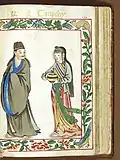
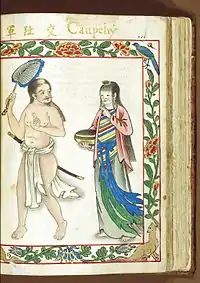

.jpg.webp)
